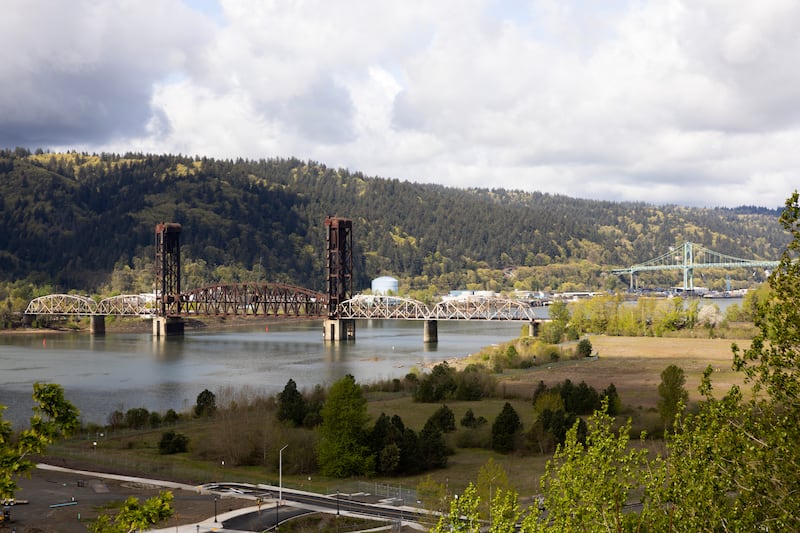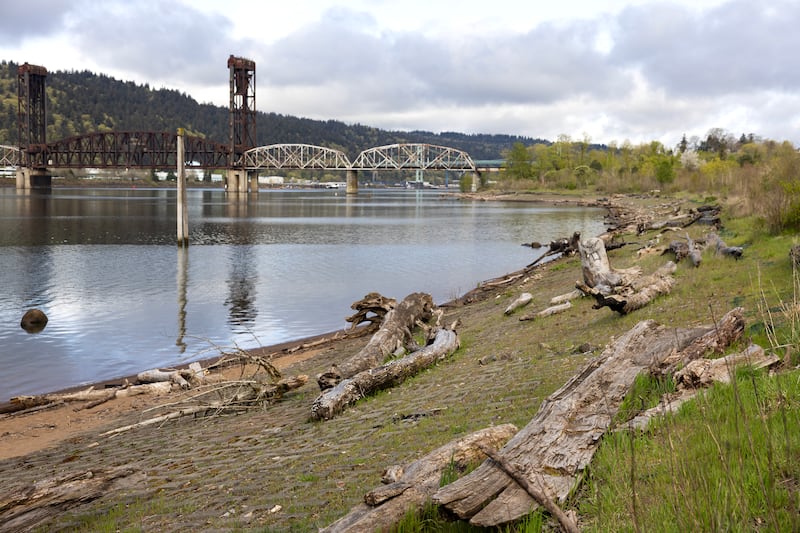Reported in Willamette Week:
Chasing Ghosts: Outdoor Adventure
- ADDRESS: 6900 N Edgewater St.
- YEAR BUILT: The creosote plant operated from 1944 to 1991.
- SIZE: 41.8 acres (land); 16.4 acres (water)
- MARKET VALUE: None
- OWNERS: McCormick & Baxter Creosoting Co.
- HOW LONG IT’S BEEN EMPTY: Cleanup completed in 2005
- WHY IT’S EMPTY: Lingering liability
There’s not much activity on the 41 acres of Willamette riverfront property immediately upstream of the BNSF Railway Bridge in the University Park neighborhood.
The beach and expansive uplands contain driftwood, migratory birds and, judging from tracks under a security gate, the occasional coyote—but no people. None legally, anyway.
That’s because, for nearly two decades, the property, formerly home to the McCormick & Baxter Creosoting Co., has existed in legal limbo. Although environmental regulators completed a $70 million cleanup in 2005, the property remains off-limits to the public and under the partial control of a defunct, bankrupt company whose owner wants to partner with a nonprofit to turn it into a ticketed botanical garden.
Portland is a river city where most of the waterfront remains in private hands or otherwise inaccessible to the public because it’s in industrial use, heavily polluted or otherwise walled off. Unlike Austin or San Antonio, Texas, or even Vancouver, Wash., Portland has turned its back on one of its greatest natural resources.
“For a place located on two rivers, we’re not a great river city,” says Travis Williams, director of Willamette Riverkeeper, a nonprofit that is pushing to open the McCormick & Baxter property to public use.
Nearby properties offer some hope. In 2018, the University of Portland revived an adjacent parcel of land, installing new athletic facilities. And just downstream, the regional government Metro is moving toward activating another stretch of the Willamette River’s industrial past at Willamette Cove, after years of agitation from local residents (“Buried Treasure,” WW, Dec. 9, 2020).
But tucked between those two parcels, the McCormick & Baxter site has lain unused, year after year. “It makes me really angry,” says Michael Pouncil, chair of the Portland Harbor Community Advisory Group. “Our government has historically been really quick about taking property away from people of color, but when it comes to giving it back, they lack the courage to use the tools available.”
After a March 20 meeting of several interested parties, however, the dam might finally be breaking.
“That meeting was a turning point,” says Kevin Parrett, who’s in charge of overseeing the site for the Oregon Department of Environmental Quality. “We are exploring all legal mechanisms to force movement from the owner, including foreclosure and condemnation.”

Many Portlanders are aware that the U.S. Environmental Protection Agency declared Portland Harbor a Superfund site in 2000, the legacy of more than a century of industrial pollution. Perhaps less well known: The McCormick & Baxter site was so dirty, it preceded the rest of the harbor into infamy, being named its own Superfund site in 1994.
The company’s former CEO, Charlie McCormick, 77, spent decades at the plant before it shut down. Tugboats pulled tows of logs—called “barkies”—upriver, where McCormick & Baxter peeled them and immersed them in creosote, a pesticide and wood preservative distilled from wood or coal.
“We produced utility poles, railroad ties, and treated lumber, and shipped those products all over the world,” McCormick says.
From 1944 to 1969, documents show, the company dumped used creosote directly into the Willamette. After that, it poured the waste into onsite holding pools, from which it seeped into the groundwater. When environmental regulators moved in, the company could not pay the cost of cleanup and declared bankruptcy. McCormick & Baxter became an “orphan” site, leaving taxpayers to pick up a $70 million tab for cleanup.
After cleanup was completed in 2005, DEQ held a legal interest in the property. McCormick & Baxter retained the title, but the state’s liens gave DEQ the right to approve or reject any sale.
McCormick says only a few serious buyers ever expressed interest.
“There are a lot of misunderstandings about a contaminated site and a lot of fear from potential users,” he says.
DEQ and EPA placed conditions on future use. Whoever owns it will be responsible for security so that monitoring wells, caps over contaminants, and other expensive mitigation features will not be damaged. And the monitoring must go on essentially forever—”in perpetuity,” DEQ says.
McCormick says he negotiated at length with the University of Portland, which hoped to expand its athletic facilities on open space at river level. “UP would have been very suitable owner,” McCormick says. “They looked at it for about 10 years, but in the end, they couldn’t make it work.”
After those talks broke off, at least three other groups expressed interest: Willamette Riverkeeper, the Bird Alliance of Oregon (formerly Portland Audubon), and a nonprofit called Portland Botanical Gardens.
Williams, the Riverkeeper director, says he had several conversations with McCormick. When those didn’t lead anywhere, the Bird Alliance worked with a lawyer and real estate expert to see if they could make a deal with McCormick. Bob Sallinger, then conservation director at the Bird Alliance, says those talks took place in 2022 and went nowhere.
McCormick says he appreciates the various groups’ interest in the site but doesn’t feel their ideas were as substantive as a proposal by Portland Botanical Gardens to erect exhibition buildings on the property and host hundreds of thousands of paying visitors annually.
“They have got a lot of the pieces in place to turn that property and the whole stretch of river into something very attractive,” McCormick says.
One piece the nonprofit doesn’t have: money. The organization was founded in 2020 but hasn’t raised or spent enough money to have filed a tax return. “They are working on raising that,” McCormick says. (A spokesperson for the organization declined to comment.)
“Charlie seemed really starry-eyed about Portland Botanical Gardens,” Sallinger says. “We met with them to see if there was common ground, but ultimately it seemed like they were just holding the property hostage.”
Others share Williams and Sallinger’s concern. “We have no interest in supporting Portland Botanical Gardens’ idea,” says Cassie Cohen of the Portland Harbor Community Coalition. “We’d like to see the site accessible to the public and to tribes for recreational, cultural and ceremonial purposes and habitat restoration.”
DEQ has run out of patience. “We don’t think Charlie McCormick is acting in good faith,” Parrett says. “He’s more of an obstacle than a partner.”
The state agency is now seeking to push for a sale to an organization that will share with the public the value of what Parrett says is one of the success stories of the interminable harbor cleanup.
“This property is like a fine bottle of wine in the cellar, ready to be opened,” Parrett says. “There aren’t any other sites like it on the lower Willamette—it’s truly a gem.”

